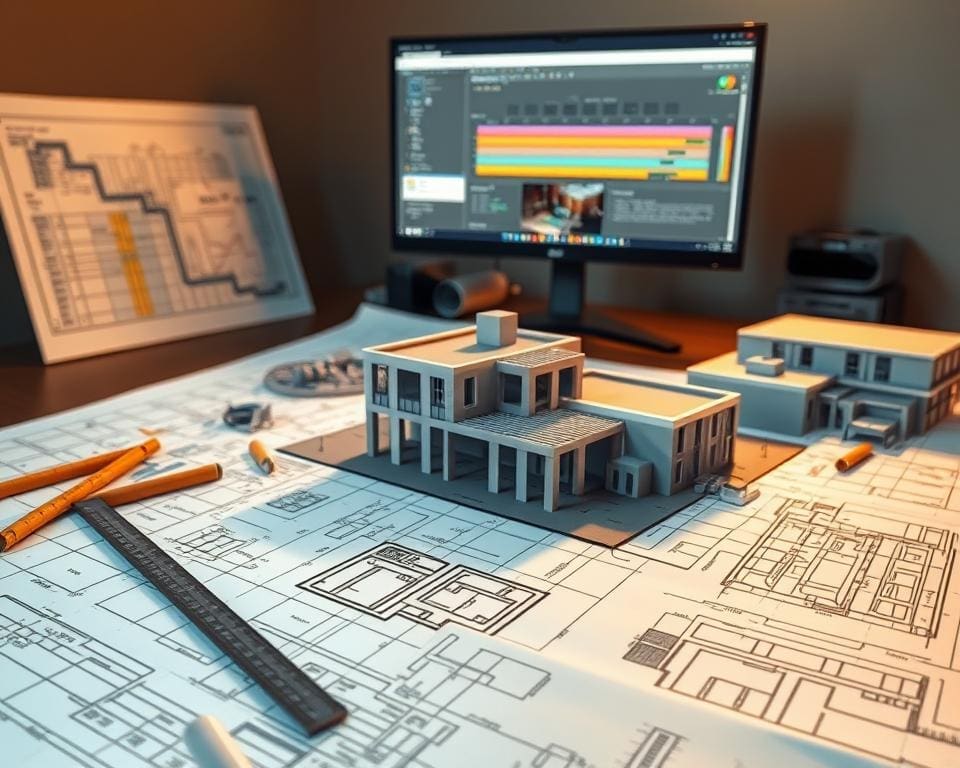In the realm of construction project planning, the importance of careful preparation cannot be overstated. How do you plan a build to minimise disruption? This question is pivotal, especially in urban settings where noise and access challenges can significantly affect daily life for residents and businesses alike. By prioritising thoughtful planning, construction teams can enhance building process efficiency, ensuring that projects proceed smoothly while respecting the surrounding community and environment.
Effective strategies not only streamline operations but also foster goodwill between builders and local inhabitants. Understanding the nuances of site disturbance management lays the groundwork for a construction journey that harmoniously integrates with its environment, paving the way for successful outcomes.
Understanding Construction Project Planning
Construction project planning serves as the backbone of any successful build, guiding each stage with precision and foresight. A thoughtful approach to planning can significantly reduce potential disturbances, ensuring that projects run smoothly and on schedule.
The Importance of a Thoughtful Approach
Implementing a thoughtful approach in construction project planning is essential for managing complexity. This method allows for careful consideration of various factors such as scheduling, budgeting, and risk management. Projects that embrace this mindset tend to navigate challenges efficiently, ultimately leading to timely completion without unnecessary detriment to the surrounding environment.
Key Components of Project Planning
Several critical components form the foundation of effective project planning. These include:
- Stakeholder engagement to ensure all voices are heard.
- Resource allocation that optimises workforce and materials.
- Environmental assessments which address potential impacts.
- Regulatory compliance to meet legal standards.
Each of these components plays a pivotal role in anticipating and mitigating issues, ultimately contributing to a well-organised and successful project.

How Do You Plan a Build to Minimise Disruption?
Planning a build with minimal disruption requires a strategic approach grounded in thorough research and community engagement. Understanding the complexities of the project site and its surroundings is essential. Adopting a step-by-step guide to address potential issues ensures a smoother construction process. Identifying potential disruptions early facilitates proactive solutions, fostering positive relationships with local residents and businesses.
Step-by-Step Guide to Planning
Begin with a comprehensive analysis of the construction site. This research should encompass existing infrastructure, environmental factors, and community concerns. Engage with relevant stakeholders, including local authorities, to gain insights into any regulations and community expectations. Formulate a detailed construction plan that outlines timelines and specific tasks while considering key factors such as:
- Traffic management to minimise congestion.
- Appropriate scheduling of noisy activities.
- Dust control measures to improve air quality.
Identifying Potential Disruptions Early
Early identification of potential disruptions proves invaluable. Focus on aspects such as noise, dust, and access challenges. Solicit feedback from the community to understand their concerns, allowing for effective communication strategies. Addressing these factors proactively lays the groundwork for a successful project while enhancing community relations.
Reducing Construction Site Disturbance
Minimising the impact of construction on surrounding areas is crucial for integrating projects successfully within communities. Various techniques can be employed to enhance the experience for everyone involved. Prioritising strategies for reducing construction site disturbance ensures smoother operations while maintaining positive relationships with residents and other stakeholders.
Techniques to Mitigate Noise and Vibration
Noise and vibration often represent significant challenges during construction. Implementing effective techniques to mitigate noise can lead to a more harmonious environment. Consider the following:
- Utilising quieter machinery and tools to lower sound levels.
- Installing sound barriers around the site to absorb unwanted noise.
- Scheduling noisy activities during off-peak hours to minimise disruption.
Such measures not only alleviate concerns but also create a more favourable perception of construction efforts.
Managing Access for Residents and Visitors
Effective communication plays a vital role in managing access for residents and visitors. Clear signage helps inform people about site boundaries and routes. Providing designated paths can enhance safety while minimising confusion. Consider the following strategies:
- Establishing a clear communication plan to keep the community informed.
- Offering maps illustrating access routes to prevent misunderstandings.
- Encouraging personnel to assist and direct visitors as necessary.
By fostering an environment that prioritises safety and clear communication, construction teams can play a crucial role in reducing construction site disturbance while ensuring continuity for those affected.
Minimizing Building Work Impact on Surroundings
Construction projects often have the potential to disrupt local communities and the environment. By prioritising open communication and sustainable practices, builders can foster a more positive experience for everyone involved. This section explores the importance of engaging with the community and promoting environmental sustainability as effective strategies for minimising building work impact.
Engaging with the Community
Establishing strong connections with the local community is essential during construction. Engaging with the community through meetings, information sessions, and feedback forms allows residents to voice their concerns and suggestions. These interactions build trust and create an atmosphere of cooperation, ultimately leading to improved project execution. Potential benefits include:
- Informed community members who understand the project’s scope and timeline.
- Enhanced cooperation with local authorities and organisations.
- Opportunity to address specific concerns that may arise during construction.
Promoting Environmental Sustainability
Environmental sustainability plays a crucial role in minimising building work impact. Implementing eco-friendly practices such as waste reduction, recycling, and using energy-efficient materials not only contributes to a greener project but also enhances its reputation within the community. Construction firms can adopt various strategies to uphold sustainable practices, such as:
- Utilising renewable resources and materials whenever possible.
- Minimising waste through efficient planning and recycling initiatives.
- Incorporating green technologies to reduce energy consumption during construction.
Effective Construction Scheduling
Effective construction scheduling plays a pivotal role in minimising disruption throughout the building process. By strategically planning the timing activities, construction teams can significantly lessen the impact on nearby residents and businesses. Maintaining a well-structured schedule allows for a smoother workflow, resulting in reduced downtime and enhanced productivity.
Timing Activities for Least Disruption
When determining the optimal timing activities, several factors must be taken into account, including local noise ordinances, peak traffic hours, and community events. Engaging stakeholders in planning discussions often yields valuable insights into the best times for construction activities. Adjusting work hours to align with community needs promotes goodwill and fosters cooperation, further reducing potential conflicts.
The Role of Technology in Scheduling
The role of technology cannot be overstated in enhancing effective construction scheduling. Digital tools and advanced software enable project managers to create dynamic schedules that can quickly adapt to changing circumstances. With capabilities for real-time updates, teams can maintain clarity regarding progress and resource allocation. This reliance on technology helps streamline communication among various stakeholders, ensuring that everyone is on the same page and ready to tackle any challenges that may arise.
Site Disruption Management Strategies
Effective site disruption management relies on strategic planning and proactive measures. A thorough approach enhances not only the workflow but also communication among all parties involved. Key to this success lies in developing a management plan that prepares teams for unforeseen challenges, while allowing for flexibility and responsiveness.
Developing a Disruption Management Plan
When creating a disruption management plan, it is essential to establish clear protocols for various potential disturbances. The plan should encompass:
- Identification of potential risks that might interrupt activities.
- Designated roles and responsibilities for team members.
- Communication strategies to keep stakeholders informed.
- Resource allocation to manage unexpected scenarios effectively.
Such a roadmap enables quicker responses and minimises overall disruption during construction activities.
Monitoring and Adjusting Plans in Real-Time
Successful site disruption management mandates consistent monitoring of ongoing operations. Regular assessments allow for fine-tuning processes where necessary. Key practices include:
- Setting up indicators for detecting disruptions as they occur.
- Gathering feedback from onsite personnel and stakeholders.
- Utilising technology to track progress and provide immediate updates.
The ability to adapt through monitoring and adjusting plans ensures all team members stay aligned and engaged with project goals.
Construction Timeline Optimization
Optimising a construction timeline involves careful planning and execution, ensuring that every phase of the project is meticulously organised. Effective strategies for setting realistic milestones and prioritising tasks can dramatically enhance overall efficiency and minimise disruptions to the surrounding community.
Setting Realistic Milestones
The foundation of successful construction timeline optimization lies in setting realistic milestones. These milestones should directly correlate with available resources and anticipated challenges. By establishing clear objectives, teams can maintain focus and motivation throughout the project. Regular evaluation of milestones allows for timely adjustments and reinforces accountability among team members.
Prioritising Tasks for Efficiency
Prioritising tasks is essential for ensuring that the construction process flows smoothly. This involves identifying which tasks must be completed first based on dependencies and resources. Effective task prioritisation not only improves workflow but also reduces the duration of critical activities. Adopting a methodical approach to task management can lead to significant time savings and mitigate the impact on the local community.
Project Management for Minimal Disruption
Effective project management is vital in achieving minimal disruption during construction activities. By implementing strategic planning and clear communication, project leaders can address potential issues before they escalate, thereby enhancing building process efficiency. A proactive approach ensures that all team members understand their roles and responsibilities, which is essential for maintaining a harmonious relationship with the local community.
A focus on adaptability is equally important. As construction progresses, unexpected challenges may arise that can affect timelines and cause disturbances. Embracing flexibility within the project management framework enables teams to swiftly adapt their strategies for minimal disruption, ensuring that work continues smoothly while respecting the needs of nearby residents.
Moreover, fostering a culture of open dialogue between construction teams and the community can pave the way for a successful project. When residents feel informed and involved, there is often greater tolerance for the temporary inconveniences that come with building work. Thus, through effective project management for minimal disruption, construction projects can not only meet their objectives but also leave a positive mark on the communities they inhabit.









